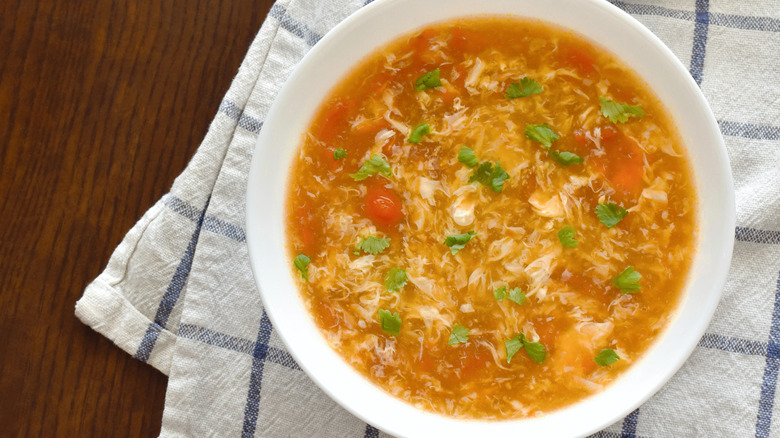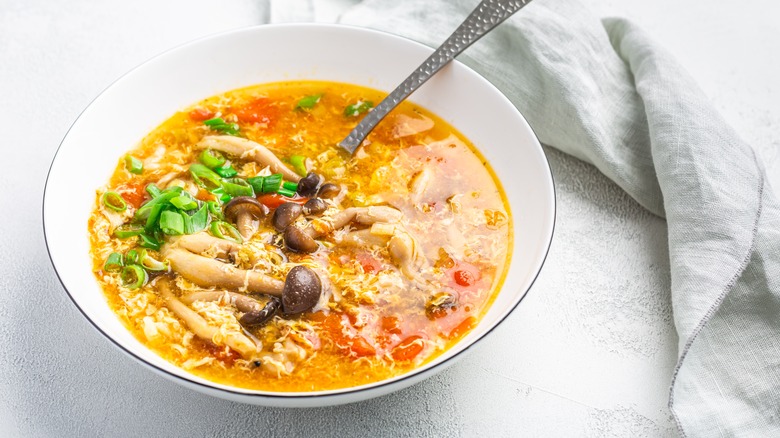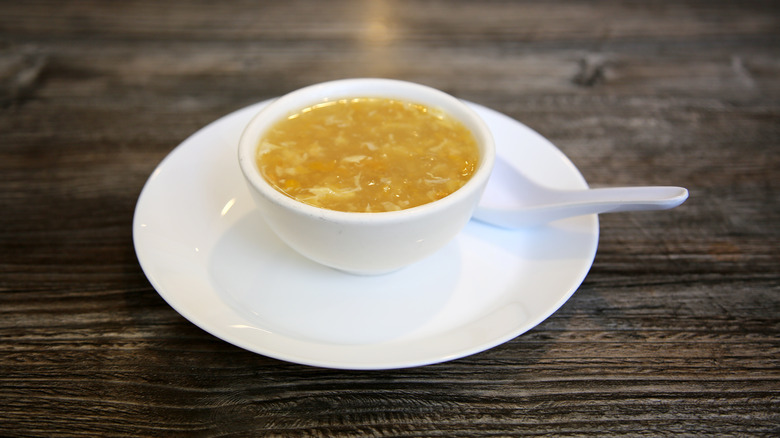How Does Tomato Egg Drop Soup Differ From The Classic Version?
You're undoubtedly familiar with egg drop soup, either from visiting a Chinese restaurant or making an easy, soothing version at home. It's a simple, elegant combination of, well, not much: Broth and eggs, maybe with some minced scallions, should it strike your fancy. What you might not have heard of is a tempting variation on this dish: A Chinese delicacy called fān qié dàn tāng, or tomato egg drop soup. With hardly any added effort, you can introduce an acidic note to the egg's creaminess, making the dish that much more complex and hardy.
You don't have to be an expert chef to immediately understand that the difference between tomato egg drop soup and the classic version is the inclusion of tomatoes. However, even that simple addition calls for a few minor adjustments in a recipe that is the soul of simplicity and brevity. Unlike Mediterranean egg-and-tomato dishes like shakshuka, this soup doesn't rely on a premade sauce but rather diced ripe tomatoes. In order to remove excess water, the tomatoes must be sautéd in oil before one gets to the egg-dropping bit.
Like its stir fry counterpart, but even quicker
Chinese cuisine, which is big on deliciousness, can also crank out some meals in short order. Such is the case with another tomato-and-egg dish from that country: Jia chang cai, or tomato egg stir fry. There's little more in this dish than tomatoes and eggs besides the stir-fry oil, minced scallions, a little sugar, and maybe some water. You'll want to have made the rice beforehand because making it is a few minutes' work.
It's similarly quick to whip up a batch of tomato egg drop soup. The lengthiest part (as with the stir fry) is sautéing the diced tomatoes for several minutes until they soften. (If you're really into smoothness, you can skin the tomatoes after soaking them in hot water). Tomato egg drop soup gives you a few additional options for variations, too: Shredded cilantro leaves will dovetail right in with the earthy brightness of the tomatoes and the herbal zing of minced scallions. You might also indulge in adding a little garlic or a slice of fresh ginger. One traditional ingredient that should never be overlooked is a pinch of ground white pepper. (Do not sleep on white pepper; in small amounts, it's total camouflaged magic.)
Health benefits of this version of egg drop soup
Sautéing tomatoes does more than remove excess water; it softens them and concentrates the flavor, including natural sugars. Sautéd tomatoes are softer, sweeter, and higher in an antioxidant called lycopene. Yes, cooking tomatoes for even as little as two minutes increases their lycopene content by over 50%; a delicious way to keep your heart healthy (by lowering "bad" and promoting "good" cholesterol) and help fight off certain types of cancers (by slowing their progression). For a dish that can be made quickly, tomato egg drop soup is remarkably flavorful, nutritious, and healthy.
During peak tomato season, there's hardly a quicker or more elegant lunch than tomato egg drop soup. The bright acidity of the tomatoes perfectly balances the eggs' creaminess, and both meld seamlessly with the broth to produce a soup that's slightly sweet and umami-forward — a wonderful way to take advantage of your garden's bounty (or a produce section's irresistible selections). With its added complexity, it might become your go-to egg drop soup.


